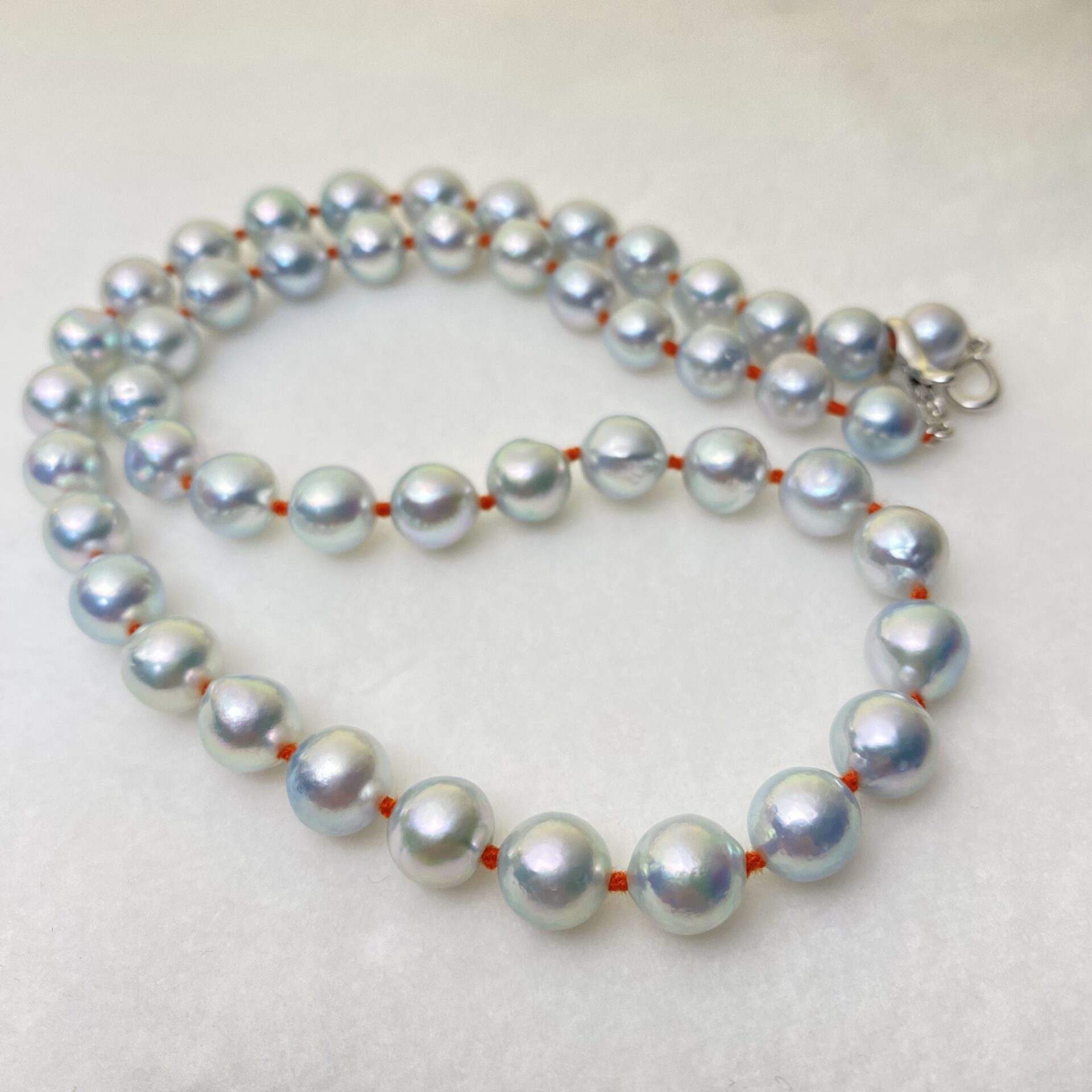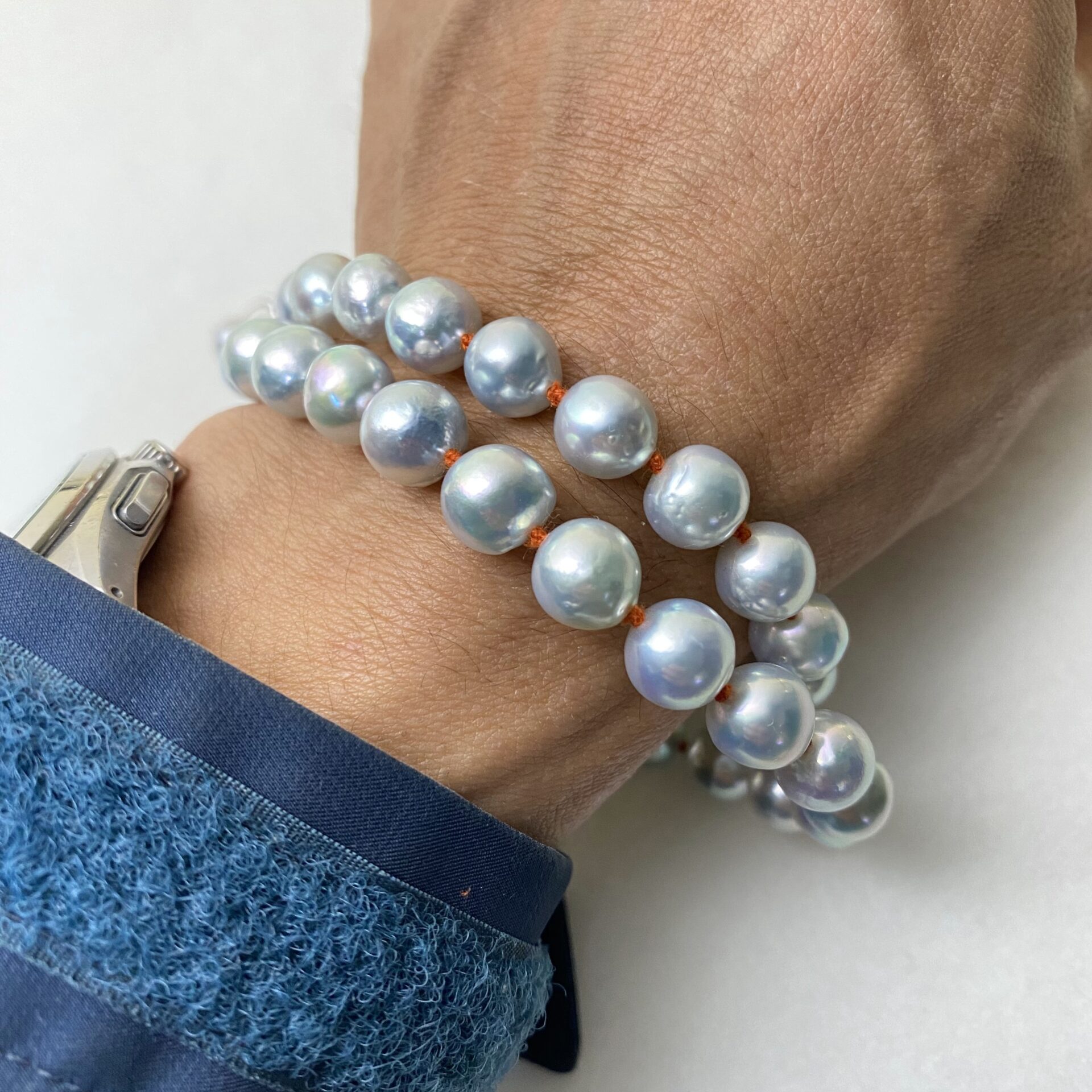

Akoya necklace
$699.00
Sold Out
**This is an Akoya pearl necklace.**
The pearls measure 8.0mm to 8.9mm in size, and the necklace has an overall length of approximately 49 cm. The pearls are gently baroque-shaped with strong luster. Even on cloudy days, the pearls seem to reflect light as though glowing from within. The color is a light blue, with subtle hints of green and soft pink visible in certain lighting.
The product images are quite accurate in representing the actual color of the pearls.
Incidentally, these pearls are from the same lot as the necklace linked below. These pearls were cultivated in “Yusu,” a region renowned in the Akoya pearl farming industry.
For more details, please refer to the product description at the link.
And the process of making this necklace is documented here, so you can see the quality of the pearls.

This necklace, like my other creations, is strung with all-knot construction. The thread may appear red, but it is more accurately described as reddish-brown.
As I write this description while holding the necklace in my hand, I notice that about 30% of the pearls have an exceptionally smooth surface. The remaining pearls have minor surface irregularities, but overall, the necklace features many lustrous and smooth baroque pearls.
Given its transparent blue base color, the necklace has a cool and refreshing impression, making it seem well-suited for summer. However, the reddish-brown thread resembles the warm tones of a reindeer, giving it a festive vibe for the holiday season as well.
—
Today is November 17, 2024. The day’s high temperature was 22°C, with a low of 17°C, unusually warm for mid-November. Starting tomorrow, the weather will finally turn more winter-like, with a forecasted high of 16°C and a low of 9°C. I am already dreading this sharp drop in temperature.
I live in Kobe, a city famous for its pearls. Since spring, Hyogo Prefecture, where Kobe is located, has been in political turmoil. The former governor was ousted following a conflict with the local assembly. Today, a new governor election is being held.
Initially, I, like many others, believed the former governor was guilty of power harassment and other misconduct, as widely reported. However, recent revelations suggest that the governor was likely targeted by the assembly for his efforts to eliminate corruption and redirect funds to support students. Despite his dismissal, his actions have started to gain recognition. Personally, I hope he gets re-elected.

However, my mother, who seldom uses the internet, still holds a negative impression of him. This underscores how crucial it is to discern the source of our information.
The same applies to purchasing pearls—where and from whom you buy is vital.
For those unfamiliar with Akoya pearls, distinguishing them from freshwater pearls can be challenging. High-quality Chinese freshwater pearls, for example, often rival Akoya pearls in appearance. However, reputable sellers transparently label their pearls as freshwater, providing details about their origin.
The natural blue pearls I mainly handle are similarly unique. Only a small percentage of Akoya pearls cultivated at farms naturally develop this blue hue. Most farms aim to produce round, white pearls, making natural blue and baroque pearls outliers.
—
To cultivate 100 round, white pearls, a farm must raise approximately 250 Akoya oysters. Even then, some oysters will die or reject the nucleus. Many of the resulting pearls may not form properly, leaving only a few that meet the round and white standard. Of these, an even smaller fraction will naturally exhibit a blue hue.
Some customers have asked why more natural blue pearls aren’t intentionally cultivated. Unfortunately, targeting blue pearls is impractical. When Akoya oysters produce blue pearls, it’s often due to stress or specific conditions, which can lead to high mortality rates and reduced overall yield.
Historically, blue pearls were considered defective. However, around 2017, the company I worked for exclusively showcased blue baroque pearls at the Hong Kong Jewellery Show. Despite skepticism from industry peers, our booth gained immense popularity, and our inventory sold out in just three days.
That experience confirmed the global appeal of blue baroque pearls, sparking my own passion for them. I even incorporated them into accessories like tie pins and cufflinks.
—
Today, approximately 70% of the world’s Akoya pearls pass through Kobe. The city has around 250 pearl businesses, many of which have been family-run for generations. Trust and transparency are the foundation of the pearl trade here.
Even so, occasional instances of deception occur. For example, several years ago, a mid-sized Kobe pearl company unknowingly sold dyed and cobalt-treated blue pearls as natural ones. This incident tarnished their reputation, as news of such mistakes spreads rapidly in Kobe’s tightly knit industry.
To ensure authenticity, I source pearls only from trusted suppliers with direct connections to reputable farms. The pearls in this necklace come from a supplier whose family has been in the pearl business for three generations, and they actively participate in exclusive auctions of freshly harvested pearls.
While imitation pearls might superficially appear flawless, genuine Akoya pearls possess an inner radiance and a natural beauty that cannot be replicated. Each pearl in this necklace, approximately 50 in total, was individually created by living Akoya oysters. This uniqueness imbues them with a sense of pride and reverence.

Most pearl enthusiasts prefer round pearls, which are highly valued but also expensive. I focus on baroque pearls because they are more affordable and offer a charm that transcends conventional beauty standards.
The pearl industry often values round pearls more highly, even when baroque pearls exhibit thick nacre and deep luster. I believe baroque pearls embody a unique beauty that deserves appreciation.
Just as every person has a unique brilliance, baroque pearls remind me that beauty lies in individuality.
Enjoy your pearl shopping!
